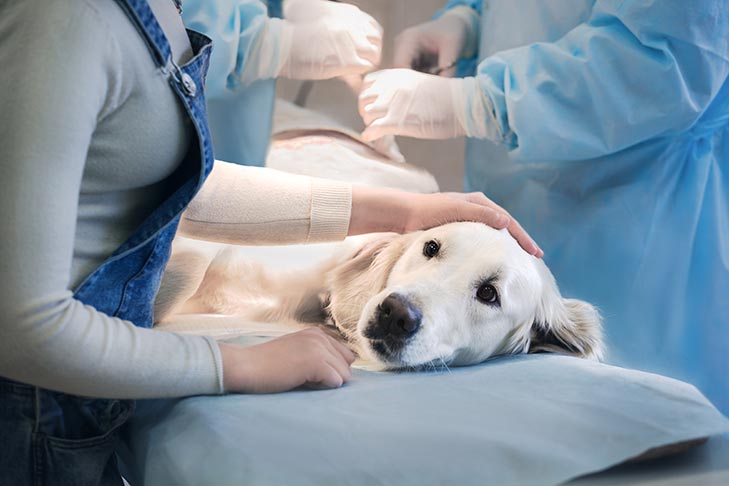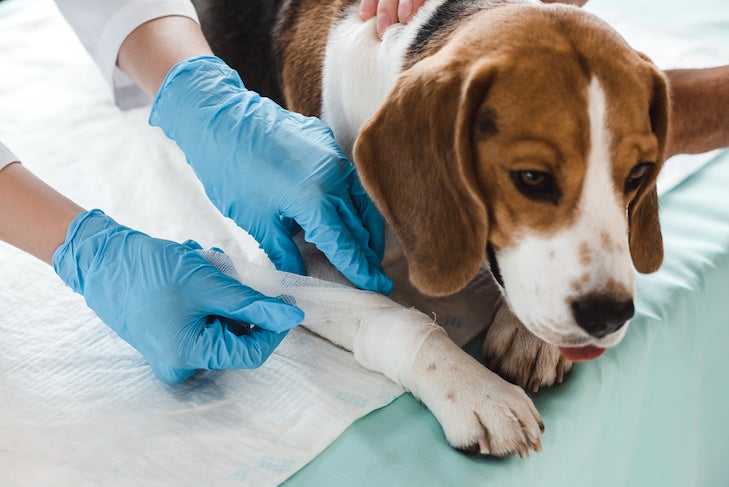When you think of the word “bacteria” you might think of something you want to get rid of as soon as possible. But dogs, just like people, normally have microbes living on and in their bodies, and they can be beneficial rather than bothersome, especially for intestinal health. However, if your dog is sick or has an injury, there’s a risk these bacteria can go from run-of-the-mill to risky. Staphylococcus (staph) infections are the most commonly-seen bacterial skin problems in dogs. Learn more about the importance of early treatment and good hygiene to keep staph infections in dogs at bay.
What Are Staph Infections in Dogs?
Dr. Brian Collins, DVM, a senior lecturer at the Cornell University College of Veterinary Medicine, explains that “many species of bacteria make up the group, or genus, known as Staphylococcus.” They typically live harmlessly in a dog’s mucous membranes around the mouth, nose, eyes, and genitals.
“One species in particular, Staphylococcus pseudintermedius, is found as a normal inhabitant on the skin of healthy dogs,” Dr. Collins says. “This and other species can create true infections in certain situations when the bacteria no longer live in harmony on the skin.” This type of bacterial skin infection is also sometimes referred to as staph pyoderma.
How Do Dogs Get Staph Infections?
Compromises in your dog’s skin barrier and immune system allow pathogens opportunities to invade the body and multiply. Scratching, licking, and chewing are common culprits of skin irritation.
“Dogs with allergies or who have diseases that weaken the immune system, such as hypothyroidism or Cushing’s syndrome, for example, can develop infections in their skin and ears or their respiratory, reproductive, or urinary tracts, in addition to other areas. Infections can also occur following surgical procedures,” Dr. Collins says.
Any dog can contract a staph infection, but puppies and senior dogs tend to have weaker immune systems and are more prone to them than healthy adult dogs.

Signs of Staph Infections in Dogs
Staph infection symptoms depend on the infection’s location in the body and how deeply the infection has penetrated. However, some signs to look out for include:
-
Inflammation around a wound that is sometimes painful, red, or hot to the touch
-
Itchiness (leading to excessive chewing and licking)
-
Skin lesions (including pustules, papules, peeling, and crustiness)
-
Hair loss
-
Coughing or labored breathing
The sooner you bring your dog to the vet and your pet is assessed, the better. Depending on your dog’s signs, your vet will need to take some skin swabs or urine samples, for example, to establish if a staph infection is in play and what treatment is likely to be most effective. Severe infection can lead to sepsis and fatalities, and you don’t want your pet to spread the infection to other dogs.
How to Treat Staph Infections in Dogs
“Milder staph infections on the skin can be treated topically with various shampoos, sprays, and ointments that contain a variety of ingredients,” Dr. Collins says. “More serious skin infections are treated with systemic antibiotics—typically given by mouth but also sometimes by injection.”
Oral or injected antibiotics also systemically treat infections in other parts of the body. Dr. Collins explains that, depending on the severity of the infection, treatment may take place at home or in a hospital setting.
Don’t be tempted to stop the course of treatment early just because you think it looks like your pet has fully recovered. Strictly following the schedule of drug administration is crucial to fully clear up the infection and minimize any antibiotic resistance or contagion.
Getting the underlying cause of the inflammation under control and repairing the skin barrier is key to reining in a staph pyoderma. If the skin or immune system remains compromised, recurring infections can be a problem.
Ongoing Treatment for Staph Allergies
In some unfortunate instances, your dog can be allergic to the Staphylococcal bacteria. This type of hypersensitivity can mean, even after a full course of treatment, the problems quickly return. There is a high level of success in keeping infections at bay by treating them through long-term desensitization.
Typically, desensitization works by the vet administering routine small-dose injections of staphylococcal bacterin (killed bacteria) over an extended period, which may stretch to several years. The hope is that this will retrain the immune system so it doesn’t react poorly to the bacteria. The injections usually start off as daily, moving to every few days and then every couple of weeks. Your vet will guide you through the process so that treatment can continue at home.
Can I Get a Staph Infection From My Dog?
Can humans contract staph infections from dogs? “Staphylococcus pseudintermedius and other species can be transferred from other dogs and even the people they live with,” Dr. Collins says. Thankfully, transmission between dogs and humans is rare, but it still pays to practice good hygiene techniques while your dog is undergoing treatment.
Can Dogs Get MRSA?
“MRSA stands for methicillin-resistant Staphylococcus aureus and refers to cases where the bacteria has become resistant to methicillin and other antibiotics,” Dr. Collins explains. It’s something that is more common in people, but it can still infrequently occur in dogs.
“In dogs, we are more concerned about MRSP, or methicillin-resistant Staph pseudintermedius, as that bacterial species is more common in dogs,” Dr. Collins says. “In either case, it is a concern because it means that the infection may be more difficult to treat, as there are fewer antibiotics available to treat it.”

Can You Get MRSA from a Dog?
While MRSA transmission from dogs to humans is rare, it is still possible. Staph infections can pass to unaffected pets, too. Following these good hygiene practices helps limit their spread:
-
Keep higher-risk young children and immunocompromised people away from infected pets where possible.
-
Wash hands after touching your dog or their bedding, bowls, and other belongings.
-
Always complete the full course of antibiotic treatment.
-
Don’t skip follow-up appointments with your vet.
-
Talk to your vet about addressing the underlying causes of any secondary infections (which may arise as a result of treating the original infection) to reduce the chances that the infection might return.
-
Clean up poop from the yard straight away.
-
Wear gloves when applying topical treatments.
-
Cover any cuts or open skin irritations you or other family members have.
-
Discourage your pet from licking humans.
-
Keep your pet away from close contact with other dogs outside the household until the infection is gone.
The post Staph Infections in Dogs: What You Need to Know appeared first on American Kennel Club.



0 Comments
Recommended Comments
There are no comments to display.